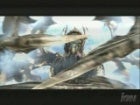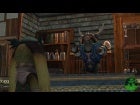The first day of the Tokyo Game Show had us running all over the place, so moments to actually get off of one's feet and play a game were few but incredibly welcome all the same. I got one of these rare breaks with Square Enix's latest quasi turn-based RPG, The Last Remnant, and while it introduces some interesting twists on traditional Final Fantasy mechanics (think old-school, not XII), it seemed to have some trouble delivering a smooth framerate, which is disconcerting considering that it ships in a little over a month.
But Does it Have Airships?
The demo focused mostly on combat and its relation to the overworld map, which in many ways is similar to Tales of Vesperia. I guided protagonist Rush through an expansive environment, in this case grassy planes, peppered with dangerous wildlife that would eventually take notice of my presence. When this happened, a small word balloon would pop up over the beast's head indicating its intentions, which were always represented by either one or two exclamation points that meant it was dead set on eviscerating poor little Rush. Apparently the creatures are quite surly in this world. I had a smidgen of time in which to react by pressing the right trigger, which would initiate combat, or face getting steamrolled by unruly rhino-monsters or pincushioned by ornery bees.
Once combat began, the action paused so that I could lay out my strategy and the strategies of the other members of my party. This is where The Last Remnant breaks from tradition a bit, because rather than giving specific orders to individual party members, you choose a basic tactic for roughly five leaders of their own parties, delegating group roles in the conflict. It functions similarly to the common JRPG turn-based mechanic, but the twist is that you lay out a basic outline for these leaders (attack, use a special attack that consumes AP or cast spells) and your leaders then command their own parties of three to four warriors to your specifications.
I was told that you don't have direct control over what each individual party member will do, but pressing the X button would reveal what each one had planned depending on the attack selection. I couldn't really verify this, however, because the text was written in Japanese.
Cut to the Quick
Battle plans laid out, I would begin the turn, but my work was far from over. While the usual turn-based modus operandi would suggest that I could sit back and watch as my characters battled autonomously until the end of the round, The Last Remnant uses randomly inserted button-pressing events to keep you in the action and generally kind of stressed out. As the teammates ran their attack patterns, I would occasionally see a button flash on the screen surrounded by a shrinking circle reminiscent of Lost Odyssey's ring system, and for all intents and purposes, The Last Remnant seemed to use this shrinking circle in the same way. I had to be quick if I wanted to hit the button at just the right time, eliciting a critical strike when attacking and a defensive counter when defending; too slow and my attack would miss or my defense became ineffectual.





